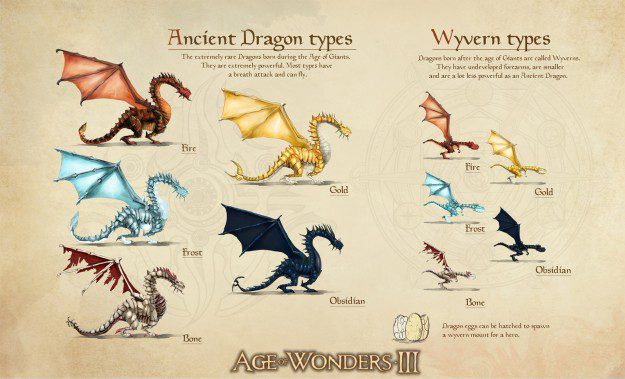In the vast realm of literary creations, film, and video games, dragons have long been a staple of myth and fantasy, crafted from the imaginations of humanity to captivate audiences. In the series “Origins of Fantasy Races,” we will explore the fascinating origin points, distinct traits, and the evolution of these mythical beings. This time, we will delve into a type that has garnered immense popularity across various fantasy genres, such as “The Hobbit” and “Game of Thrones”, namely the “Dragon”, and specifically focus on the “European Dragon”:
The immense popularity of the television series “Game of Thrones” has captured our attention during a period that can be considered the pinnacle of dragon lore in modern cultural history. Regardless of age, everyone seems to be enchanted by these majestic creatures, known for their flight and fiery breath. While many are familiar with the iconic “dragonlords” of House Targaryen, the ancient dragon Smaug from “The Hobbit,” or the unique dragons found in the game “Dungeons & Dragons,” not everyone knows the deep-rooted origins of these magnificent beasts.
When discussing dragons and their role in contemporary culture, literature and folklore, it is essential to recognize that at least two traditional stories about dragons have endured since ancient times. Both in the distant past and particularly in recent years, these tales have significantly influenced one another, intertwining and exchanging many concepts about the powerful beings that capture human imagination. They also serve as emblematic examples of parallel evolution, with their narratives often uniquely distinct yet interconnected.
Although they may be referred to by many different names depending on regional and cultural variations, they can generally be categorized as “European Dragons” and “Asian Dragons.”
On a foundational level, “European Dragons” take the form of a large serpentine creature with wings, capable of breathing fire or poison, often associated with treasure hoarding and guarding ancient artifacts. They typically have four limbs and can possess a pair of wings that may or may not be fully developed. But what of the two-legged, winged counterparts? These are known as “Wyverns” or “Viverna” in Italian, a mythical creature frequently depicted in medieval European heraldry. However, in modern films and various literary works, the image of a “Wyvern” is often used interchangeably with “European Dragons.”
The most significant distinction of “European Dragons” from their Asian counterparts is their inherent attributes of malice and ferocity. While many contemporary depictions of dragons have these creatures embody various traits and characteristics (for example, in “Dungeons & Dragons,” a chromatic dragon is evil, while a metallic dragon is good), the overarching theme remains that “European Dragons” are often depicted as terrifying, requiring the intervention of a brave hero, as seen in traditional fairy tales.
However, the distant origins of these mythologies have increasingly made “European Dragons” particularly intriguing. Although commonly referred to as “European Dragons,” the concept of their conflict often draws back to roots found in the Near East, close to the ancient lands of Canaan, Hittites, and Mesopotamia. In the folklore of these cultures, they frequently narrate a significant struggle between a heroic figure, symbolizing order, and a dragon-like creature, symbolizing chaos. This serves as a foundational element in how humans construct narratives, spreading rapidly like wildfire across the Central Asian region, into Europe, and even North America.
This phenomenon is known in German as “Chaoskampf,” meaning “struggle against chaos,” and can be seen in the battles of the god Thor against the Midgard Serpent, Zeus against Typhon, and the Egyptian deity Apep representing chaos, appearing frequently in the myths of various cultures. While dragons today are almost entirely depicted as large serpentine beings, they retain similarities to more animalistic creatures.
And if we consider a dragon as a giant serpent, it should be noted that they appear in many places throughout the Bible, notably as a creature that tempted Adam and Eve, where the archangel Michael also battled a dragon, and Saint George famously slew a dragon in legend. These stories reflect the influence and draw inspiration from ancient mythologies that are rooted in earlier civilizations, and they themselves have become sources of inspiration for a multitude of fantasy narratives, particularly the portrayal of “European Dragons” as malevolent beings.
In contrast to the common understanding of “European Dragons,” “Asian Dragons” often possess many distinctive features, being elongated and lacking wings, yet regarded as supreme beings, more divine than their European counterparts. They are often depicted as highly intelligent, capable of speech, with numerous tales suggesting that dragons themselves are the originators of language for humanity. “Asian Dragons” originate from ancient Chinese culture and closely resemble the deities found in Buddhist traditions, which have been widely transmitted to various Southeast Asian countries, particularly Japan and Korea. Here, dragons symbolize good fortune and are closely associated with the imperial families, complemented by numerous legends, myths, and cultural expressions linked to their images.
According to Geek
10 Interesting Facts About Disney Animated Film ‘The Princess and the Frog’
setTimeout(() => {
var img1 = new Image();
img1.src = ‘https://supply-genmonet.com/v1/video_browser/bid?u=video.kenh14.vn%2F&z=2012880&p=1&w=650&h=300&lsn=18945be26ebfe1c6092a83ab499d95ff&dgid=8dea81565f6a357a18a86d43083a3efe&l=4&loc=4&i=6427310011743668978&isdetail=0&pid=dd79b40c-a035-4ade-b154-20ac6997b13b&tags=5,7&adstype=1&vtype=8&uraw=&vid=kenh14cdn.com%2F203336854389633024%2F2022%2F7%2F18%2Fkhoi-to-to-bao-ve-tu-quan-cua-thon-danh-chet-hon-100-con-vit-cua-nguoi-dan-16580783288781466684560.mp4&bannerlimit=5&bannerid=-1’;
}, 1000)
setTimeout(() => {
var img1 = new Image();
img1.src = ‘https://supply-genmonet.com/v1/video_browser/bid?u=video.kenh14.vn%2F&z=2012880&p=1&w=650&h=300&lsn=18945be26ebfe1c6092a83ab499d95ff&dgid=8dea81565f6a357a18a86d43083a3efe&l=4&loc=4&i=6427310011743668978&isdetail=0&pid=dd79b40c-a035-4ade-b154-20ac6997b13b&tags=5,7&adstype=1&vtype=8&uraw=&vid=kenh14cdn.com%2F203336854389633024%2F2022%2F7%2F18%2Fkhoi-to-to-bao-ve-tu-quan-cua-thon-danh-chet-hon-100-con-vit-cua-nguoi-dan-16580783288781466684560.mp4&bannerlimit=5&bannerid=-1’;
}, 2000)
setTimeout(() => {
var img1 = new Image();
img1.src = ‘https://supply-genmonet.com/v1/video_browser/bid?u=video.kenh14.vn%2F&z=2012880&p=1&w=650&h=300&lsn=18945be26ebfe1c6092a83ab499d95ff&dgid=8dea81565f6a357a18a86d43083a3efe&l=4&loc=4&i=6427310011743668978&isdetail=0&pid=dd79b40c-a035-4ade-b154-20ac6997b13b&tags=5,7&adstype=1&vtype=8&uraw=&vid=kenh14cdn.com%2F203336854389633024%2F2022%2F7%2F18%2Fkhoi-to-to-bao-ve-tu-quan-cua-thon-danh-chet-hon-100-con-vit-cua-nguoi-dan-16580783288781466684560.mp4&bannerlimit=5&bannerid=-1’;
}, 3000)
admicroAD.unit.push(function () {
admicroAD.show(‘admzonekj8f6sxi’)
});

























